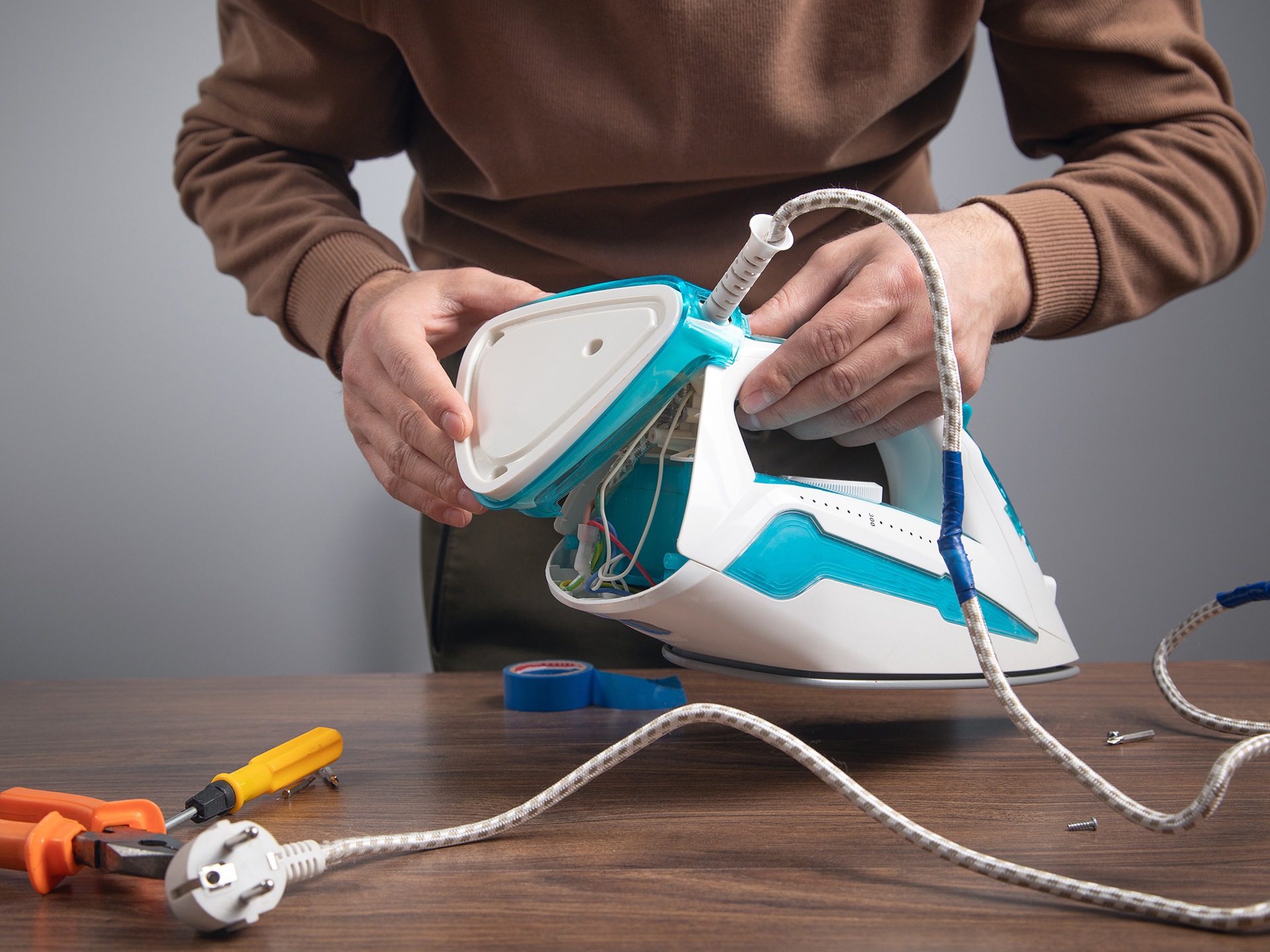Repair is the new Replace: sustainable ways to fix up your property
Why more people are choosing to mend their home appliances and gadgets instead of buying new ones – and where to start if you’ve got something that needs fixing
Repair is the new replace. To help save the planet – and save themselves cash – more and more people are demanding manufacturers make it easier to mend stuff.
Here’s why this ‘right to repair’ matters – plus where you can get information, parts and advice if you’ve got something broken that needs fixing.
Why repair matters

Image credit: Adobe Stock
William Hobbs, sustainability expert at MyJobQuote.co.uk, explains, “Although about 75% of the materials in household electricals – metal such as steel etc – can be recycled, some parts can’t be recycled, or are difficult to recycle without using lots of energy.
“That’s why repairing appliances when they break rather than buying new is a good way to reduce waste and lower your carbon footprint.”
This is the reason consumer advocates, environmentalists and keen amateur repairers are fighting for products that are easier to repair.
The idea is consumers will buy less new stuff if they can repair their old electronic goods and household appliances themselves – or get them repaired more easily.
A culture of repair could mean less waste, and the use of fewer natural resources in the first place: both wins for the planet.
If it’s broke…
As things stand, getting our possessions fixed isn’t always as easy as it could be…
We’ve all been there: an appliance or gadget stops working and we haven’t the faintest idea where to start with a repair.
Has the battery gone or is it something more serious? Could we even physically take the thing apart if we wanted to? Or is it a sealed unit?
YouGov research has shown just how few of us are up for tackling repairs of household goods.
Meanwhile, there’s a million other calls on our time.
So, the easiest and quickest thing to do is buy a new one and enjoy your shiny new ‘toy’, while – best-case scenario – the old kit gets recycled, or – worst case – it gets binned and ends up in landfill.
E-waste
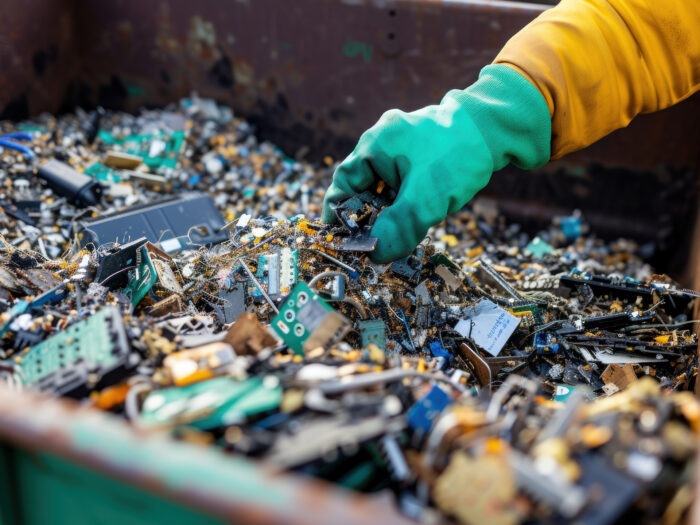
Image credit: Adobe Stock
And this same wasteful cycle is repeated any time something breaks. Which is why, to quote just one damning statistic, the UK has ended up as the world’s second highest generator of electronic waste per person, producing 24kg e-waste per capita in 2022.
Built-in obsolescence
Some manufacturers have played a part in this wasteful state of affairs by ‘designing in obsolescence’, ie they have made products harder to fix – or even deliberately fast to fail – to encourage us to purchase again, as a way to boost sales.
There are lots of different ways they can do this: by making it almost impossible to take a product apart and access the working parts – or even just to change the batteries – for example.
Or they can say unauthorised repairs will invalidate the warranty. Or they use impenetrable proprietary software. There are lots of tricks in that particular book.
History of repair

Image credit: Adobe Stock
This ‘built-in obsolescence’ goes back to the middle of the last century when maintenance and repair fell out of favour as Western consumer societies became rich enough to simply dispose of appliances at the first sign of trouble, instead of getting things mended.
Before that, most people weren’t affluent enough to be able to replace possessions each time they broke. Instead, things were repaired – whether that meant darning clothes or bodging furniture.
Throughout history until very recently, thrifty folk without the cash for repetitive replacement maintained and cared for their possessions to give them a longer life.
Built-in obsolescence
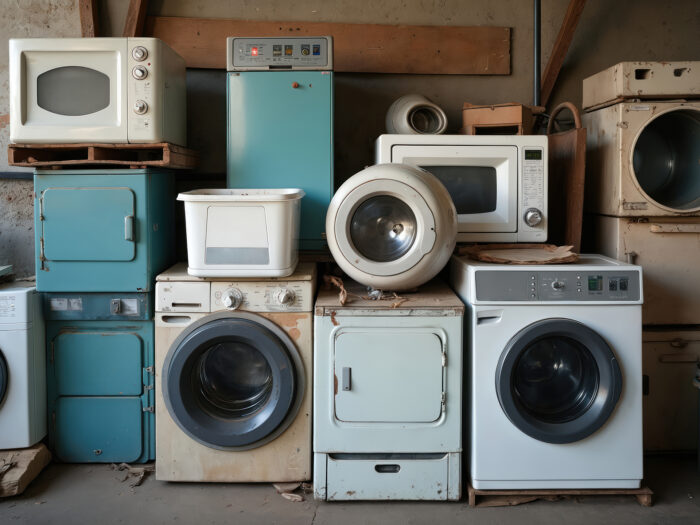
Image credit: Adobe Stock
But, as advertising and increased prosperity fuelled a consumer boom after the second world war, some companies began to choose built-in obsolescence as a way to stoke and sustain demand.
An American economist Victor Lebow described what was happening at the time like this: “Our enormously productive economy demands that we make consumption our way of life, that we convert the buying and use of goods into rituals, that we seek our spiritual satisfaction, our ego satisfaction, in consumption.…
We need things consumed, burned up, replaced and discarded at an ever-accelerating rate.”
And so built-in obsolescence, new models, and product restyles arrived to fuel demand.
Of course, not all obsolescence is planned. Good old-fashioned entropy – and the fast pace of technological change – means that most possessions we’ve had for a while, and used a lot, will stop working at some point, regardless of how well designed they are.
It’s complicated
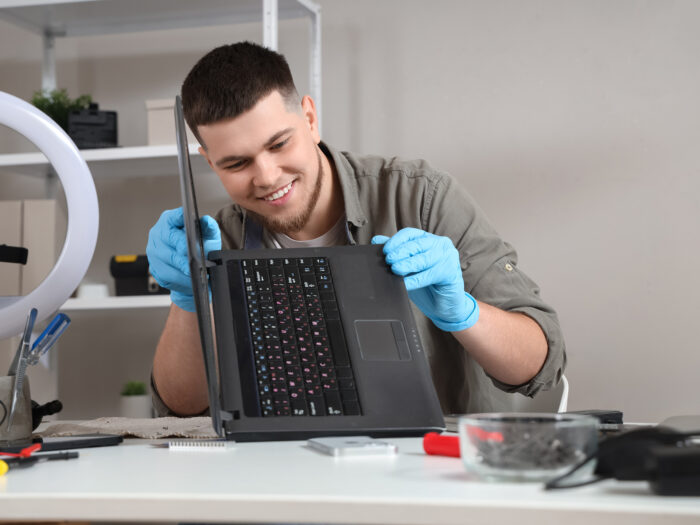
Image credit: Adobe Stock
And it’s not just a simple case of ‘evil’ corporations with an agenda to thwart repair. The reality is more nuanced.
There are many and varied factors that mitigate against companies producing repairable goods. Jo Barnard, designer at industrial design consultancy Morrama, gives some examples.
She says, “For so long, as industrial designers, we’ve been designing products to feel impenetrable – hiding all those fixings because they were seen as ‘flaws’ in a perfect surface. Now, we’re having to think how can we make those things visible.
“It is actually fairly easy technically to make things repairable – to make the screw fixings visible and so on.
For example, at Morrama we’ve designed Kibu a pair of repairable headphones for kids where any part can be easily removed and replaced.

Kibu repairable children’s headphones
“The difficulty is usually not about how to make a product repairable, it’s about how to create the system that allows for that repair.
For so many products, particularly tech products, companies don’t encourage repairs because their health and safety teams are too scared by what could go wrong if they let customers just get at it with a screwdriver.
“Then the spare parts are another issue: an inventory challenge. Knowing how many parts to order in the first place; then where and how to store them; distribute them; get them out to customers. And so on.”
A lot of it comes down to risk-averse corporate legal teams.
Jo says, “You can imagine a world where companies could have their own online channels where members of the public could upload user-generated repair content – crowdsource ‘how to’ videos and so on.
But legal teams would be frightened of the firms becoming liable; of someone coming along and saying, ‘You linked me to this YouTube channel, and someone put up this video, and I followed it, and then I electrocuted myself. So now I’m going to sue you.’”
Toaster still going strong

Image credit: Dualit
None of these barriers to repair are insurmountable with the right attitude.
As Jo says, “It’s all doable – and there are some brands that manage to do it really well. “Dualit is a good example. They’ve got a lovely spare parts list on their website.
“My dad’s Dualit toaster is older than I am and it’s still working well! He has replaced the elements in that toaster a bunch of times over my lifetime. And it’s still going strong,” she smiles.
The ‘right to repair’
The ‘right to repair’ movement is attempting to challenge the bad habits of throwaway consumerism – in both manufacturers and consumers.
The focus is on making spare parts and repair information easily available, so people can either fix products themselves, or take them to independent repair shops.
Jo suggests there are several drivers behind the repair trend: as well as the cost of living and environmental awareness, there’s an increasing willingness to buy second-hand.
The idea that ‘new to me’ is still new started in the fashion sector but is spreading to other goods.
She says, “We’re starting to buy second-hand things more, and to understand that we don’t need to have brand new all the time. And, in due course, that will translate into repairing things.”
More repair shops
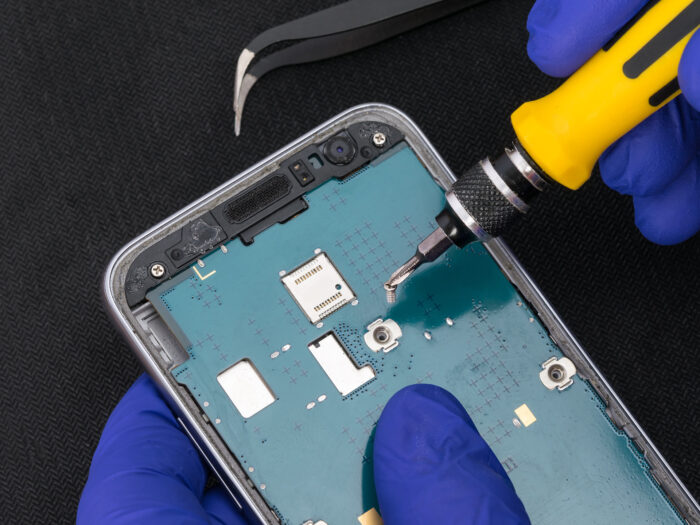
Image credit: Adobe Stock
Jo believes a greater willingness to repair will lead to three things:
Firstly, people repairing things themselves. Secondly, a new repair sector will develop.
She says, “Repair shops are becoming more common on the high street.
“People are realising they can take their phone with a smashed screen into a repair shop in the morning, go to work, and pick it up at the end of the day, fixed.
“The old idea that you’ve got to send it off for three days and it’s going to cost you hundreds of pounds is rubbish.”
Second-hand markets
The third likely effect will be the creation of second-hand markets.
Jo says, “You’ll also find repair shops and second-hand retailers collecting old items – that laptop with just one port that’s broken; the phone with a smashed screen; the toaster where the element’s gone – and repairing them for resale.
“A ‘back market’ in refurbished tech is growing. And I think the same will happen for appliances too. Some manufacturers will begin buying back their own products for refurbishment and resale, too.
“To facilitate all these things, brands need to move towards using more standardised components.
“And then, aside from personal tech, there’s no reason why products need to be completely sealed or miniaturised to a crazy extent.
“But these things are all resolvable. With so much of the stuff we use, there’s just no reason why it shouldn’t be made repairable.”
UK regulations

And, indeed, progress is being made. Ecodesign and Energy Efficiency regulations introduced in 2021 brought in some limited ‘right to repair’ rules.
Makers and importers of some household appliances – washing machines, washer driers, dishwashers, fridges, and electronic displays – now have to make spare parts for their products available for at least ten years after the product has been discontinued.
They must also ensure repairs are possible using commonly available tools, and maintenance and repair information must be made available to professional repairers.
So makers of these products now have spare parts available on their websites, and many have their own networks of authorised repairers.
Campaigners say this doesn’t go far enough though. They would like to see the regulations extended to more products, and the requirement to offer repair information extended to include end-users as well as professionals.
Human nature
We must take responsibility as consumers too, though: this is an ‘us’ thing just as much as a ‘them’ thing.
We are the ones who choose to keep buying new stuff because it’s easier and more convenient…
Independent vs authorised repairers
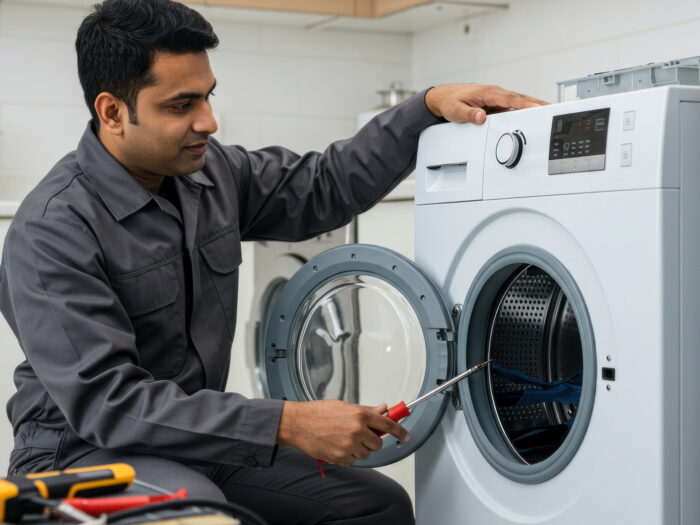
Image credit: Adobe Stock
To date, it has generally been easier to find parts and repairers for more expensive products – tech and white goods – than for small household appliances.
But more and more home appliance makers are making spare parts available too, including companies like Beko, Bosch, Dualit, Dyson, Hoover, Hotpoint, Indesit, Karcher, Neff, Numatic (Henry), Samsung, and Zanussi – and repairers are starting to reappear having nearly disappeared from our high streets.
William says, “When you need an appliance or electrical item repaired, check to see whether it can be repaired through the manufacturer or whether they recommend a repair service.
“If not, look for a local repair company with a good reputation.”

Parts available: Henry Hoover
Here are some things to consider when you’re choosing whether to use a brand-authorised repairer or an independent:
Brand-authorised repairer
Pros:
- genuine parts – which should ensure compatibility and potentially make for longer-lasting repairs
- warranty coverage – if your appliance is still under warranty, a brand-authorised repair will likely not void it
- specialist expertise: brand-authorised technicians are trained on the specific appliances they repair.
Cons:
- more expensive – can be more expensive
- limited availability – may not be available for all brands in all areas.
Independent repairer
Pros:
- cost effective – independent repairers may offer lower prices for the same repairs
- convenience – may be more readily available and offer faster turnaround times
- flexibility – may be more willing to work with you on repair options and alternative solutions.
Cons:
- part quality – may use generic or aftermarket parts, which might not be as durable as genuine parts
- warranty void? – repairs by an independent repairer could void your warranty, depending on the specific warranty terms
- lack of expertise – some independent repairers may not have the same level of expertise or training in your appliance as brand-authorised technicians, particularly when it comes to complex repairs.
Advice and spares
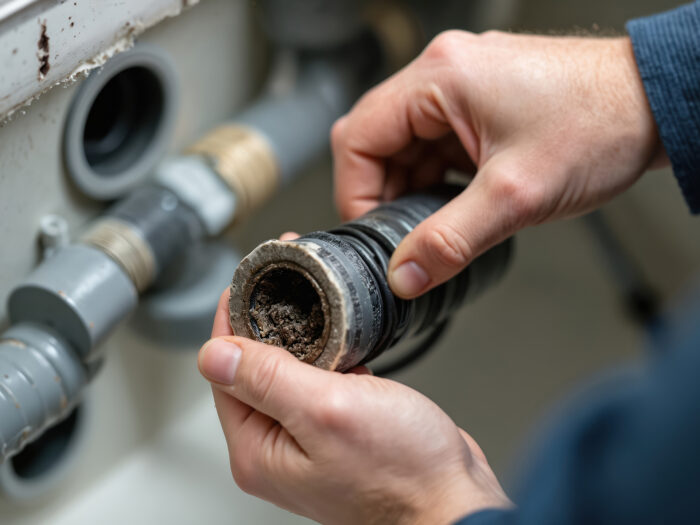
Meanwhile, if you’d like to try tackling a repair yourself, there are more and more places online and IRL that you can go to for help, including:
- ifixit.com a one-stop-shop for tech repairs
- espares.co.uk to buy parts for white goods and appliances and find how-to repair videos and instructions
- repair cafés
- YouTube videos
- independent repairer and engineers
- Restart’s Repair Wiki a good place to start full of helpful advice for beginners and general rather than model-specific fixing advice and chat.
ifixit
ifixit.com is an online resource where you can search a bank of 120,000 tech repair guides covering 66,000 devices, plus their shop has a range of common parts and tools that you might need.
espares
espares sells more than a million spare parts for over 500 appliance brands, plus 800 advice articles, 11,000 repair videos and 11,000 product manuals you can download.
Fixpart is another website offering millions of spares for household goods.
Repair cafés

Image credit: Adobe Stock
William recommends, “To save money when you’re getting small items repaired, it might be worth looking to see if there’s a community repair café in your area.
“Volunteer run, these can help you learn how to fix items like coffee makers, bikes, laptops, clothes and furniture.”
These local community get-togethers with a purpose – run by keen DIYers and engineers motivated by green principles – can be a great place to get advice on DIY repairs.
Some 37,000 repairs were made at repair cafés around the world last year, and many towns in the UK now have their own where you can take your broken stuff to get a repair or expert advice on a fix.
Find your nearest repair café
The Community Repair Network is an umbrella body for groups organising repair cafes.
It maintains a list of repair cafés across the country where you can look for your nearest.
Saving money

Meaco’s new Sefte cooling fan has a removable and replaceable battery
And, of course, if you do manage to repair something, the benefits aren’t just environmental.
You’ll save money – and gain a great sense of satisfaction.
Conscious consumerism
For things to change further, we’ll also need to be more considered in our choice of appliances in the first place; and think long-term and investigate repairability, rather than just letting ourselves be dazzled by the big brands’ latest models.
Whether you prefer to blame it on human nature or on capitalism, our desire for shiny new goods means we are highly susceptible to built-in obsolesce of a psychological kind.
We love to be seen with the latest gadgets and possessions – as status symbols. And that desire is impossible to legislate away. But you can learn to think before you buy…
Repairable products can be more expensive than basic models – but this has to be set against the saving on replacement costs.
Similarly, repairable products often don’t look as sleek, slim and shiny as big-brand kit.
Repairability ratings

Bosch – parts available. Image credit: Quiet Mark
When it comes to choosing new products, William says, “If you’re buying new appliances, look for products that are designed to be repairable and have affordable parts available from the manufacturer.
“As well as checking whether goods are repairable, consider quality: well-made products are less likely to break and should have a longer lifespan.”
If repairability is something you value, you can check out the repairability of products before you buy them using ifixit’s repairability ratings for phones, tablets, ear buds, laptops, e-readers, smart watches, and mini PCs.
Repairability ratings for white goods are on the horizon, too.
France has its own Repairability Index rating system – the first in the world. And the EU looks may follow its lead.
Unintended consequences
So far so good, all this sounds great. But, as with all legislation, there is a danger of unintended consequences from right-to-repair legislation…
They found possible unintended outcomes of right-to-repair legislation could include the manufacturers of cheap goods reducing the price and durability of their products to maintain sales; and manufacturers of more expensive goods bundling free repair in with purchase price, and passing the cost of this on to consumers.
Another unintended consequence could be prolonging the lives of energy-guzzling, inefficient products…
They envisage a scenario where right-to-repair legislation could create “a ‘lose-lose-lose’ situation that compromises manufacturer profit, reduces consumer surplus, and exacerbates the environmental impact despite repair being made easier and more affordable.”
None of which means repairability isn’t a sensible sustainability goal, it just suggests there aren’t necessarily legislative ‘easy fixes’…
Other ways to encourage repair

Bosch Tassimo – parts available
Jo points out there are other ways product designers could encourage repairs.
She says, “One simple thing you could do would be to ship products with the back off.
“So, when you bought a toaster, say, it would come with the shell off, so that you could see all the bits and bobs inside.
“Then the last thing that you’d have to do before you could use it would be to put that piece on and close it up.
“That way, you’d know that that comes off, and you know that you can get access to all those things.”
Appliance e-logbooks
She continues, “Another thing I’d like to see is QR codes you could stick onto appliances, which link to a very simple website that is effectively an electronic version of a car logbook but for appliances.
“Users could upload information to build up a body of repair knowledge.”
Whether it’s through legislation or creative design, with so many of us feeling the pinch these days, the trend for repair looks like it’s here to stay – for financial as well as environmental reasons.
One last story from Jo shows why: “My air fryer stopped working recently.
“When I put the pot in, it wasn’t registering – the sensor had gone.
“I really wanted to fix it, so I went online and found a great little video made by a member of the public showing how to fix it.
“The machine could have been better designed for assembly and disassembly.
“But, regardless, using the video, I was able to fix it. Which meant I didn’t have to buy a new £189 air fryer.”
READ MORE:

